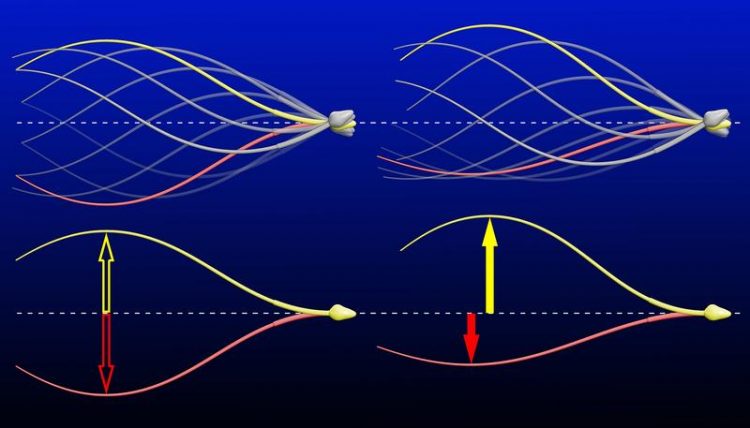Sperm navigate by playing chords

Figure 1. Steering by a temporal break of the beat symmetry. Dr. Luis Alvarez & Dr. René Pascal / Stiftung caesar
It is a matter of scientific debate how microswimmers navigate. This fundamental question concerns scientists seeking to understand biological microswimmers, such as sperm, or engineers striving to design synthetic micro-robots.
The sperm tail serves multiple purposes: it is used as a propeller that drives sperm forward, as an antenna that captures and processes sensory stimuli, and as a “rudder” that sets the course accordingly. Sperm swim forward by waving their tail.
As the wave travels from the head down to the tip of the tail, liquid is pushed backwards and sperm are propelled forward. For steering, the tail beats asymmetrically to one side, acting like the rudder of a boat; consequently, sperm move on a curved path.
The new study shows that sperm use a surprising mechanism to produce an asymmetric beat. Two different waves travel along the tail: one with a fundamental frequency and another with twice this frequency. To put it in musical terms, sperm play notes of different octaves. The superposition of these two waves results in a wave with an amplitude that changes in time. The tail undulates more to one side compared to the other.
This time-modulated wave provides the essential feature for steering: liquid is pushed asymmetrically, but in contrast to the rudder of a boat, the symmetry is broken in time rather than in space. The study also shows that, when sperm sense the female hormone progesterone, the frequency, amplitude, and phase of the two waves is adjusted and thereby also the swimming path. Thus like fine-tuned instruments, sperm play chords orchestrated by the chemical signals encountered while cruising along their path.
Original publication
Guglielmo Saggiorato, Luis Alvarez, Jan F. Jikeli, U. Benjamin Kaupp, Gerhard Gompper, and Jens Elgeti (2017) “Human sperm steer with second harmonics of the flagellar beat” Nat. Commun.
Contact
Dr. Luis Alvarez
Project group leader for biophysics of cell motility
Department Molecular Sensory Systems
E-mail: luis.alvarez@caesar.de
caesar foundation
The caesar foundation is associated with the Max Planck Society and operates a center for neuroscience research in Bonn. The scientific work is carried out according to the excellence criteria of the Max Planck Society.
https://www.caesar.de/en/our-research/molecular-sensory-systems/project-groups/b…
https://www.caesar.de
Media Contact
All latest news from the category: Life Sciences and Chemistry
Articles and reports from the Life Sciences and chemistry area deal with applied and basic research into modern biology, chemistry and human medicine.
Valuable information can be found on a range of life sciences fields including bacteriology, biochemistry, bionics, bioinformatics, biophysics, biotechnology, genetics, geobotany, human biology, marine biology, microbiology, molecular biology, cellular biology, zoology, bioinorganic chemistry, microchemistry and environmental chemistry.
Newest articles

NASA: Mystery of life’s handedness deepens
The mystery of why life uses molecules with specific orientations has deepened with a NASA-funded discovery that RNA — a key molecule thought to have potentially held the instructions for…

What are the effects of historic lithium mining on water quality?
Study reveals low levels of common contaminants but high levels of other elements in waters associated with an abandoned lithium mine. Lithium ore and mining waste from a historic lithium…

Quantum-inspired design boosts efficiency of heat-to-electricity conversion
Rice engineers take unconventional route to improving thermophotovoltaic systems. Researchers at Rice University have found a new way to improve a key element of thermophotovoltaic (TPV) systems, which convert heat…



